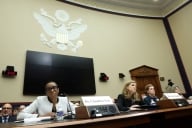You have /5 articles left.
Sign up for a free account or log in.
WASHINGTON -- Just as Congress ratchets up its scrutiny of for-profit higher education as a whole, the body’s investigative arm is calling on the U.S. Department of Education to begin examining some of the same issues of value and quality at foreign medical schools where Americans use federal student loans. The largest of such schools are for-profit institutions.
In a report released Monday, the Government Accountability Office recommends that the department begin collecting data on student debt levels, graduation rates and licensure exam pass rates to better understand where federal funding is going when students choose to use it at foreign medical schools.
GAO’s analysis found that first-time pass rates for all three stages of the United States Medical Licensing Examination were significantly lower for students using federally guaranteed loans at foreign medical schools than they were for students at U.S. medical schools. Students didn’t know how much debt to anticipate -- estimates in focus groups ran from $90,000 to $250,000 (in the United States, the median medical student loan debt was $155,000 in 2008) -- and had mixed assessments on the quality of their institutions’ instruction and educational facilities.
“Little is known about international medical graduates with respect to how much they borrow over all, or the outcome of their medical studies, leading some policy makers to question the federal return on investment in IMGs,” wrote George A. Scott, GAO’s director of education, workforce and income security issues. Those questions led Congress to mandate, in the Higher Education Opportunity Act of 2008, “that GAO study the performance of IMGs educated at these schools and other aspects of a foreign medical education.” The study released Monday was the result.
In 2006, Jordan J. Cohen, then-president of the American Association of Medical Colleges, bemoaned the lack of substantial outcomes data on foreign medical schools and criticized "offshore but incoming" Caribbean medical schools for being large, for-profit and of questionable quality. (He did, however, conclude that they were -- with proper quality controls -- essential to providing the supply of physicians needed to meet future demand.)
The GAO found that while 97 percent of U.S.-educated students passed the Step 1 licensure exam on the first try between 1998 and 2008, only 64 percent of students at foreign schools passed.
Between 1998 and 2008, American students borrowed $1.5 billion in federal loans to attend freestanding foreign medical schools. Another $1 billion in loans went to students attending foreign universities that have medical schools, though because the Department of Education does not track academic disciplines, it’s not known what percentage of those loans went toward medical education.
And the trend has been toward an ever-larger percentage of federal student loan dollars going to students at foreign medical schools, as tuition and student enrollments at those institutions rise, the GAO found. During the 1997-98 academic year, students borrowed $72 million to use at foreign medical schools. In 2007-8, they borrowed $315.1 million -- growth of 338 percent. At the same time, the program offering the loans, the Federal Family Education Loan Program, grew at less than half that rate. (FFEL will be replaced with direct loans effective July 1.)
GAO staff also visited five foreign medical schools: American University of the Caribbean, in St. Maarten; Ross University, in Dominica; St. George’s University, in Grenada; Royal College of Surgeons, in Ireland; and Poznan University of Medical Sciences, in Poland. The three institutions in the Caribbean were for-profit institutions that received the largest volume of American students and loans over all; the two in Europe were nonprofit institutions with smaller loan volumes and enrollments than the Caribbean institutions. Costs ranged from $30,000 to $90,000, the upper level within the range of tuition and expenses at private, nonprofit U.S. medical schools.
“We are pleased to have been a participant university and agree with the GAO’s emphasis on maintaining quality and accountability among foreign medical schools,” Sharon Thomas Parrott, senior vice president of government and regulatory affairs at DeVry, Inc., Ross's owner, said in a statement. Thomas Parrott was the sole representative of for-profit higher education to testify at last week’s Senate Health, Education, Labor and Pensions Committee hearing on the sector.
Based on its findings, GAO made four recommendations to the Department of Education:
- Collect consumer information on student debt levels and graduation rates from foreign medical schools and make it publicly available.
- Require foreign medical schools to submit annual aggregate licensure exam pass rate data.
- Verify school-submitted data, possibly by verifying with the USMLE.
- Evaluate the potential impact of Congress’s newly enacted 75 percent pass rate requirement for participation in the federal student loan program.
David A. Bergeron, the Education Department’s acting deputy assistant secretary for policy, planning and innovation, wrote in a letter to GAO that the department agreed with all four recommendations, but cautioned that the last two suggestions might be more difficult to implement. The verification “will require the cooperation of the private organizations that administer the exams,” Bergeron said, and “[t]o this end, we will again attempt to establish a data sharing agreement with those organizations.”
Bergeron noted that the department had already begun evaluating the potential impact of a 75 percent pass rate requirement through the development of rules on foreign institutions set to be published this summer in a Notice of Proposed Rulemaking.








